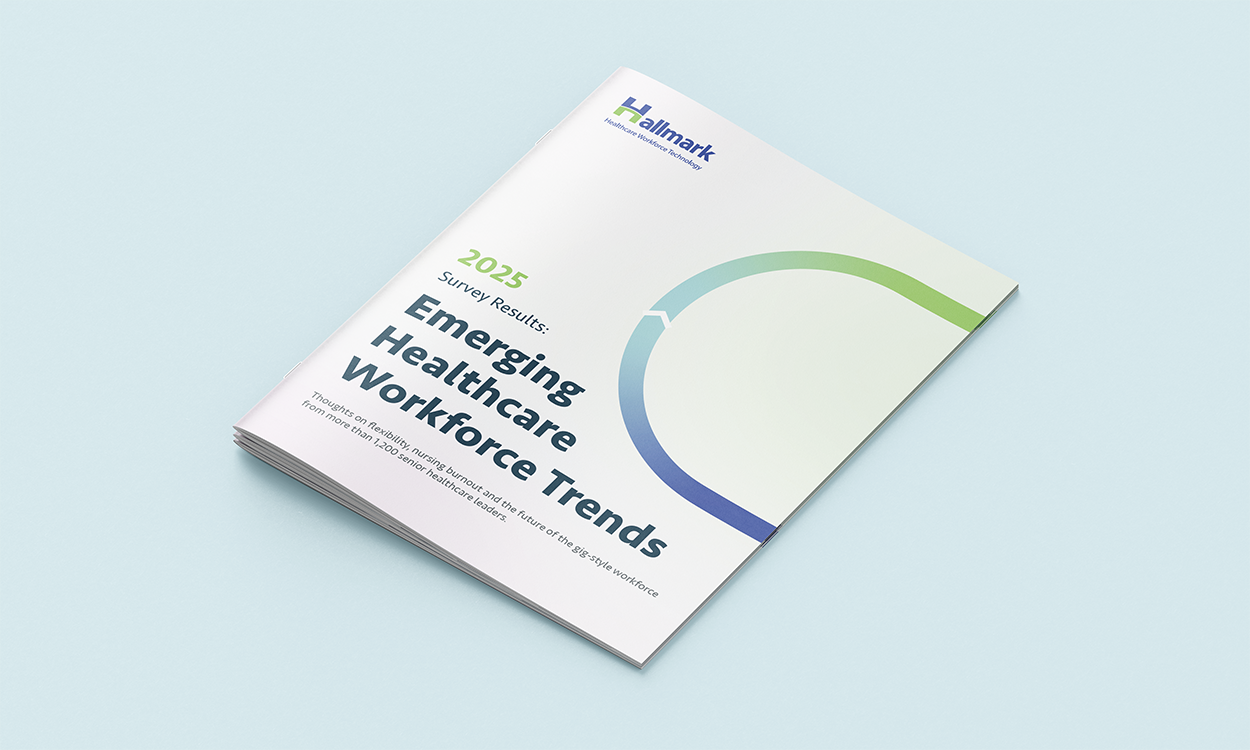Executive Summary: The New Era of Healthcare Staffing—2025 Workforce Trends

Industry
Healthcare
Challenge
Healthcare organizations are facing escalating labor costs, clinician burnout, and severe staffing shortages. Traditional staffing models are no longer adequate to meet the demands of today's flexible and autonomous workforce.
Results
The survey findings highlight the urgent need for flexible staffing models. 98% of healthcare leaders report increased demand for gig-style work, while 89% feel pressured to cut staffing expenses. Additionally, 95% are concerned that staffing shortages may impact patient care quality.
Key Product
Hallmark's Einstein II Contingent Labor Platform
Rethinking our staffing strategy is crucial, as relying on travel and contract nurses to fill shifts is a costly and unsustainable solution. In contrast, investing in our permanent staff and exploring flexible scheduling models can help reduce labor costs and improve staff morale.
Senior Healthcare Leader
Survey Respondent
Filling shifts with travel or contract nurses significantly increases our costs, with hourly rates 1.5 to 2 times higher than permanent staff, plus additional agency fees.
Healthcare Executive
Survey Respondent
Rethinking our staffing strategy is crucial, as relying on travel and contract nurses to fill shifts is a costly and unsustainable solution. In contrast, investing in our permanent staff and exploring flexible scheduling models can help reduce labor costs and improve staff morale. By adopting a more proactive and innovative approach to staffing, we can better manage our budget and prioritize patient care.
Healthcare Executive
Survey Respondent
A sobering statistic, for every shift we fill with travel or contract nurses, our labor costs balloon by 20-30%, a stark reminder that our staffing strategy needs a serious reboot
Senior Healthcare Leader
Survey Respondent

About the Survey
Our survey methodology ensured that results represented a cross-section of U.S. hospitals. Responses came from over 1,200 healthcare leaders from diverse institutions. Because of the depth and breadth of responses, we’re confident these results offer insights applicable to any U.S. healthcare organization facing clinical staffing shortages.The Challenge
Healthcare organizations are grappling with escalating labor costs, clinician burnout, and severe staffing shortages. Traditional staffing models have proven inadequate to meet the demands of today’s workforce, which values flexibility, autonomy, and innovation. The unsustainable reliance on travel and contract nurses further compounds the issue, inflating labor costs by 20-50% and threatening the quality of patient care.
The Results
- There Is an Immediate Demand for Flexibility
Burnout, unappealing shifts, and staffing shortages are among the top challenges nurses experience. Flexibility can help solve these issues.- 98% of healthcare leaders report increased demand for gig-style work
- Flexibility is now a top driver of nurse satisfaction, and pay is less important than previously thought.
- Flexible staffing models lead to higher engagement, improved patient care.
- Labor Costs are Unsustainable
Over-reliance on travel and contract nurses inflates costs by 20-50%. While 89% of respondents feel pressured to cut staffing expenses. - There are Still Technological Limitations
Most organizations lack effective tools to support flexible workforce models.- 94% use technology for staffing, but 92% find it difficult to integrate with their systems or fuel flexibility in a scalable way.
- Barriers include high costs, scheduling limitations, and leadership buy-in.
- Quality of Care is at Risk
Burnout and disengagement directly threaten workforce morale and safety outcomes.- 95% are concerned that staffing shortages may impact patient care quality.
- 98% have observed a correlation between staff engagement levels and patient satisfaction or outcomes.
- 63% of respondents had 25% or more of their shifts go unfilled due to staffing shortages.
- Adoption of Contingent Labor Models
Where do leaders all agree the market is shifting? More flexible models fueled by technology that include a mix of permanent staff and contingent labor. Contingent Labor Workforce Models empower nurses to choose shifts, reducing dissatisfaction and burnout.- 96% believe gig-style work will play a significant role in the next five years.
- 92% are exploring flexible staffing models, such as float pools and contingent labor platforms.
- 94% also believe their organization would benefit from technology/apps that enable nurses to register and pick up shifts at their convenience.
The Next Steps
It’s clear that the traditional staffing models are quickly going to become things of the past. Which is good news for both nurses and health care organizations. How are they planning to move forward? By developing a homegrown, flexible workforce that’s empowered to decide how, when, and where they want to work, aligned with your org’s needs.
That’s where Hallmark comes in. We encourage our clients, and everyone in the industry, to evolve into the future of healthcare staffing. We’re helping them build a modern clinical workforce that shows up more engaged, performs better, and costs less – because they work for you.
